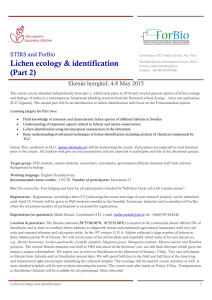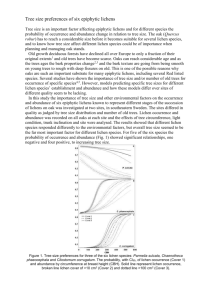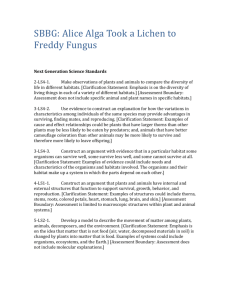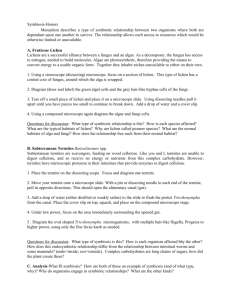PowerPoint Presentation - Lichen and Plant Polysaccharides
advertisement
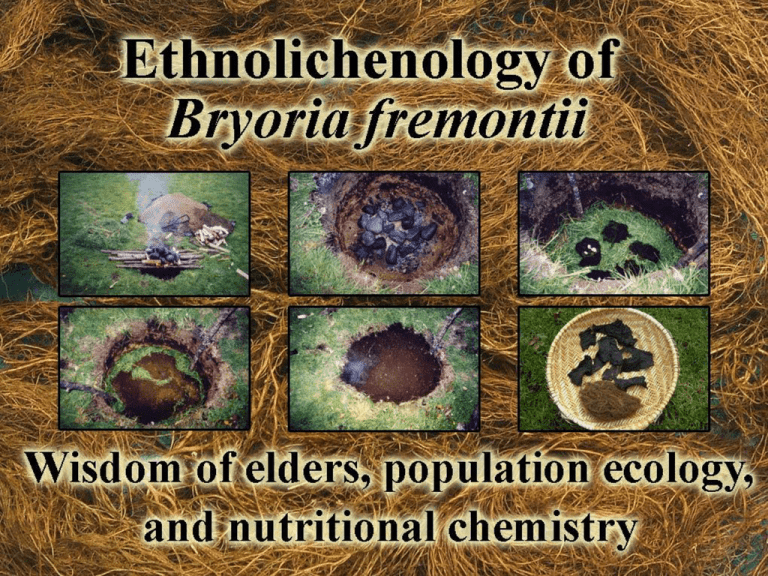
Title page 2 Map of lichen use 3 Lichens as dye Photos by S. Sharnoff 4 Lichens as medicine Peltigera canina • Cure for rabies Lobaria pulmonaria • For lung ailments Usnea longissima • Antibiotic Photos by Stephen Sharnoff 5 Lichens as decoration Usnea sp. Cladina stellaris Sooke Papua New Guinea Photo by S. Sharnoff 6 Lichens in cosmetics Evernia prunastri • Perfumes • Hair powder • Embalming mummies Photo by S. Sharnoff 7 Lichens as food Over 90 species of lichen traditionally eaten worldwide Always cooked in specific ways • Remove lichen acids • Render lichen digestible? Photo by S. Sharnoff Lobaria scrobiculata • Eaten raw by Yup’ik Yoshohito Ohmura (Japan): tasty Lobaria & seaweed soup Cooking Lobaria pulmonaria My recipe: Norstictic acid (bitter red dye) removed with baking soda 8 9 Usnea sp. Fuji saruogase U. trichodeoides • Tastes good Yokowa saruogase Usnea diffracta • Tastes bad Chili con Usnea Prepared by Mr. Sato (Japan) Rock Tripe (Umbilicaria spp.) 10 Eaten in eastern and northern Canada: • Boiled several times, eaten in soup, or with fish roe Photo by Stephen Sharnoff Also eaten by early European explorers: • Minimal preparation and limited nutrition Iwa-take (Umbilicaria esculenta) • Delicacy in Japan ($100/lb) • Deep fried, pickled, in soups, etc. Photos by Y. Ohmura 11 Cetraria islandica • Was important food in Europe • Soaked in ash water, boiled, rinsed, dried, ground, mixed with flour, then cooked • Bread, pudding, desserts Photo by S. Sharnoff Sweden, 1868: • Pamphlet distributed to teach poor people to eat lichen 12 Bryoria fremontii Alectoria jubata (out-dated name) Black moss (English layperson) Black tree lichen (ethnobotanists) Edible horsehair lichen (lichenologists) Wila (Secwepemc) /wí7e (Nlaka’pmx) A.wi’.a (Stl’atl’imc) Photo by S. Sharnoff Skwelíp (Okanagan) Wa-kamwa (Tenino) Sqwelíp (Halkomelem) /ho.póp/ (Nimi’ipuu) Sáw"-t-m=qn (Spokane) Teh-ra (Dakelh) Sä’tc’Etct (Schitsu’umsh) Caúmtemkan or st’telu (Flathead) Qa’l (Modoc) Whyelkine (Tsimshian?) Ä'ttla or emgo'tlna (Ktunaxa) Dehtsighu (Inland Dena’ina) Ik!u'nuc (Ila’xluit) Nakuraartum nuyii (Sugpiaq) Kw”u’nch (Sahaptin) 13 Bryoria use map 1 Ranges of lichen species Edible lichen Bryoria fremontii 14 Bryoria use map 2 Ranges of lichen species Edible lichen Bryoria fremontii Both edible and toxic lichen species Toxic lichen Bryoria tortuosa 15 Bryoria use map 3 Ranges of lichen species Edible lichen Bryoria fremontii Both edible and toxic lichen species Toxic lichen Bryoria tortuosa Use by people Important food 16 Bryoria use map 4 Ranges of lichen species Edible lichen Bryoria fremontii Both edible and toxic lichen species Toxic lichen Bryoria tortuosa Use by people Important food Minor food 17 Bryoria use map 5 Ranges of lichen species Edible lichen Bryoria fremontii Both edible and toxic lichen species Toxic lichen Bryoria tortuosa Use by people Important food Minor food Unconfirmed food 18 Bryoria use map 6 Ranges of lichen species Edible lichen Bryoria fremontii Both edible and toxic lichen species Toxic lichen Bryoria tortuosa Use by people Important food Minor food Unconfirmed food Other use Miscellaneous uses of Bryoria 19 Photo by Subiyay Photo by Nancy Turner Photo by Dorothy Kennedy Eating Bryoria fremontii Photo by Dorothy Kennedy Avoiding bitter and toxic lichens 1. Collect from areas identified to have good lichen 2. Thoroughly clean lichen (soak, rinse, beat, scrub) 20 Eating Bryoria fremontii Pit cook procedure used in: BC: Dakehl, Ktunaxa, Secwepemc, St’at’imc, Nlaka’pamux, Okanagan Washington: Okanagan, Spokane Idaho: Schitsu’umsh Montana: Flathead Oregon: Ila’xluit, Sahaptin 1. Dig a large pit 2. Heat up rocks in fire 21 Eating Bryoria fremontii 22 Pit Cook Procedure 3. Cover hot rocks with dirt 4. Insert stick into dirt 5. Cover dirt with wet vegetation 6. Add well cleaned lichen 7. Add layer of root vegetable (yellow avalanche lily, wild onion, camas) Eating Bryoria fremontii Pit Cook Procedure 8. Cover lichen with wet vegetation 9. Cover with dirt 10. Pull out stick 11. Pour in water 12. Cover hole 13. Let sit for 12 h to 3 days 23 24 The final product Two questions: How are toxic/bitter Bryoria spp. avoided? What nutritional value does the lichen have? Selecting edible lichen 25 A variety of similar-looking species to avoid Photo by S. Sharnoff Photo by S. Sharnoff Bryoria fremontii Wila Edible lichen Bryoria tortuosa Toxic vulpinic acid Photo by S. Sharnoff B. pseudofuscescens Tqwesimáka7 Bitter lichen compounds 26 Fremontii - tortuosa continuum 27 Identifying the right lichen Start by looking in the right place: • Location • Tree species Bring samples to grandma, and she identifies by: • Taste • Appearance 28 A simple study on collecting Bryoria • Bryoria spp. collected from 80 trees at 8 locations • Used likely collection sites within Secwepemc territory • Bryoria species composition identified for each sample • Some samples shown to Mary Thomas to determine suitability for eating 29 Different sites have characteristic Bryoria communities Kruskal-Wallis test • Variation between sites greater than variation within sites 30 The abundances of certain Bryoria morphotypes are correlated with each other Principal Component Analysis 31 The abundances of certain Bryoria morphotypes are correlated with each other Principal Component Analysis Kendall’s W • Several concordant groups Spearman test • B. implexae negatively correlated with B. fremontii 32 Asking an expert Light-coloured or yellowish lichen is not good for eating Avoided: • B. implexae • Yellow B. tortuosa Preferred: • Dark B. fremontii Dr. Mary Thomas 33 Asking an expert Light-coloured or yellowish lichen is not good for eating Avoided: • B. implexae = less B. fremontii Dr. Mary Thomas • Yellow B. tortuosa = more brown B. tortuosa Preferred: • Dark B. fremontii = more light B. fremontii A simple way to select edible lichen! 34 The nutritional value of Bryoria fremontii Protein: 4–8% Fat: Minimal Vitamins: B9, B12, E, and choline in some lichens, but not Bryoria Minerals: Ca and Fe in some lichens, but not Bryoria Carbohydrate: 20-30%, but is it useful? Lichen and Plant Polysaccharides Amylose (Plant starch) -(1-4)-D-glucan n = 250 to 5,000 Isolichenin (Lichen starch) -(1-3)(1-4)-D-glucan n = 40 to 50 Cellulose (Plant cell walls) -(1-4)-D-glucan n = lots Lichenin (Lichen starch) -(1-3)(1-4)-D-glucan n = 60 to 70 36 Eating indigestible carbohydrates Inulin (in camas) Indigestible to humans Lichenin (in Bryoria) 37 Eating indigestible carbohydrates Heat Acidity Time Inulin (in camas) Lichenin (in Bryoria) 38 Eating indigestible carbohydrates Digestible simple carbohydrates 39 Important aspects of a pitcook Temperature: ??? A theoretical model for heat flux in a pit cook xt= s + [( r - s r-d · erf 2·h·t0.5 2 r-d a= 2ht0.5 erf = 2-0.5 r-d b= 2ht0.5 0 e-2d ±1∓x = 2ht0.5 ) ] r+d (e-a2 - e-b2)·2·h·t0.5 + erf + 2·h·t0.5 d·0.5 ( ) Variables t = time r = initial temperature of hot rock s = initial temperature of soil d = distance from hot rock r = radius of hot rock h2 = thermal diffusivity 40 Important aspects of a pitcook Temperature (ΌC) Temperature: ??? Food Predicted 100 80 60 40 20 0 10 20 30 40 Time (h) Peacock’s pitcook • British Columbia, 1998 • Good fit with the temperature model 50 41 Important aspects of a pitcook Food Predicted 100 80 60 40 20 Temperature (ΌC) Temperature (ΌC) Temperature: ??? 600 Rocks Food Predicted 500 400 300 200 100 0 0 10 20 30 40 Time (h) Peacock’s pitcook • British Columbia, 1998 • Good fit with the temperature model 50 0 12 24 36 Time (h) Pagoulatos’ pitcook • Texas, 2005 • Really hot rocks • Does not match model 48 42 Important aspects of a pitcook Food Predicted 100 80 60 40 20 Temperature (ΌC) Temperature (ΌC) Temperature: Food maintained at 100ºC, then cools 600 Rocks Food Predicted 500 400 300 200 100 0 0 10 20 30 40 Time (h) Peacock’s pitcook • British Columbia, 1998 • Good fit with the temperature model 50 0 12 24 36 Time (h) Pagoulatos’ pitcook • Water maintains food at a stable thermal maximum • Higher boiling point? 48 43 Important aspects of a pitcook Temperature: Food maintained at 100ºC, then cools Acidity: ??? Potential sources of acidity Soil: As low as pH 5.0 Vegetation: Conifer 4.0, broad leaf 5.5 Root veggies: Usually 4.9–5.6 Fruit: As low as 3.0 44 Important aspects of a pitcook Temperature: Food maintained at 100ºC, then cools Acidity: Probably above pH 4, possibly as low as 3 Potential sources of acidity Soil: As low as pH 5.0 Vegetation: Conifer 4.0, broad leaf 5.5 Root veggies: Usually 4.9–5.6 Fruit: As low as 3.0 45 Important aspects of a pitcook Temperature: Food maintained at 100ºC, then cools Acidity: Probably above pH 4, possibly as low as 3 Duration: Left for 12 h to 3 days, time at stable thermal maximum depends on rock temperature Testing the effects of pit cooking 46 Real vs. artificial The real thing • More representative of reality? Faster and easier • More replicates More control • Higher consistency • Better to test specific factors 47 Pitcooking in the kitchen 48 A pit cooking experiment Black tree lichen Two kinds of food Camas 49 A pit cooking experiment Black tree lichen Camas Three different treatments Time • 6 to 34 hours Acidity • pH 7, 5, and 3 Synergy • Cooked together or separate 50 What happened to the food when cooked separately Lichen Digestible sugar (mg/g) 25 Camas Glucose 20 15 10 5 0 0 10 20 30 Hours cooked • Glucose does not increase with cooking time or acidity 40 0 10 20 Hours cooked • Not much glucose 30 40 51 What happened to the food when cooked separately Lichen Digestible sugar (mg/g) 25 Camas Glucose Fructose 20 15 10 5 0 0 10 20 30 Hours cooked • Glucose does not increase with cooking time or acidity • No fructose 40 0 10 20 30 40 Hours cooked • Not much glucose • Lots of fructose when cooked 52 What happened to the food when cooked separately vs. together Lichen Digestible sugar (mg/g) 25 Camas Glucose Fructose Cooked together 20 15 10 5 0 0 10 20 30 Hours cooked • Captures large amount of fructose from camas • Captures some glucose 40 0 10 20 30 40 Hours cooked • Perhaps retains more fructose 53 Total sugar content cooked separately Glucose Fructose Lichen Camas Cotton (around camas) 0 6 10 18 26 34 0 6 Hours cooked 10 18 26 34 54 Total sugar content cooked separately vs. together Glucose Fructose Cooked Lichen together Camas Cotton (around camas) 0 6 10 18 26 34 0 6 Hours cooked 10 18 26 34 55 Total sugar content as calculated from best fit models Sugar content when cooked separately 56 Total sugar content as calculated from best fit models Sugar content when cooked together 57 Conclusions Ethnolichenology • Lichens have a variety of traditional uses • Food lichens are prepared in specific ways to make them non-toxic and nutritionally valuable 58 Conclusions Traditional knowledge of Bryoria • Bryoria fremontii is an important food lichen • There is a lot of wisdom about the proper selection and preparation of this lichen 59 Conclusions Selecting edible Bryoria • Identifying the appropriate morphotype for eating is essential • Colour-based ID can successfully differentiate edible lichen at the relevant scale 60 Conclusions Nutritional value of black tree lichen • Lichens not digestible even with processing 61 Conclusions Nutritional value of black tree lichen • Lichens not digestible even with processing • Black tree lichen could function as a nutrient enhancer in traditional pitcooks Acknowledgements Dr. Nancy Turner and Dr. Mary Thomas for their knowledge and advice Dr. Peter Constabel and his lab Dr. Barbara Hawkins and her lab Dr. Nancy Turner, Dorothy Kennedy, Stephen Sharnoff, and Yoshohito Ohmura for pictures All of the elders who shared their knowledge



